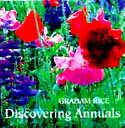
|
|
|
Fleuroselect When so many new bedding
plants are introduced every year, it's difficult to
decide which really are good. One way is to check
the catalogues for the little red and green symbol
which marks the Fleuroselect medal
winners. Fleuroselect organises the
trialling of new varieties in 25 European sites
from Italy to Scandinavia, there are five British
sites including the trial grounds at Unwins and
Thompson & Morgan. Flower seed companies from
all over the world submit their latest varieties
before they go on sale and these are grown on each
site and compared with the most similar existing
varieties. All new varieties entered
for the trials are grown under code numbers to
ensure anonymity and are judged according to the
same carefully controlled criteria. Marks are
awarded for habit of growth, uniformity, freedom
and length of flowering, and tolerance of disease
and bad weather. Marks are also awarded for sheer
beauty and also for the extent to which the variety
represents a significant advance. Varieties which gain 75%
of the maximum possible marks are awarded a Gold
Medal and others which don't quite make Gold are
awarded the Quality Mark. For 1995 four Gold Medals
have been awarded and 23 have the Quality
Mark. This all sounds very fine,
but does it work? Well, it didn't at first. In the
early years Gold, Silver and Bronze medals were
awarded and the voting system allowed many
varieties which were singularly unsuitable for
British conditions, like five zinnias, to gain
medals because they did so well in southern
Europe. Then from 1990 the rules
changed to create only Gold Medals and Quality
Marks and the judging criteria were adjusted in the
light of nearly twenty year's experience during
which time, in Britain at least, gardeners paid
little attention to the awards. Now, they are more
relevant. One nagging suspicion
survives. Although all varieties are entered under
code numbers so that their raisers cannot be
identified, the experts who do the judging and the
committee which runs the organisation have a pretty
shrewd idea of who has entered what. As a result
there is a feeling in the seed trade that sometimes
there is a little juggling of the final
results. It is also clear that many
flower breeders do not enter their best varieties,
preferring to keep them under wraps until they can
organise a dramatic launch. In the last six years the
system has certainly improved and in general
varieties awarded Gold Medals are now perhaps more
dependable than earlier winners. But by publishing
all the national scores, everything would be seen
to be fair and we in Britain might spot varieties
which have done well here, if not in Europe as a
whole. Gallery of
Gold Twenty eight Gold Medals
have been awarded since the system changed in 1990
and some of the earlier medal winners would have
gained a Gold under the new system. This is my top
ten of the medal winners which are still listed in
the mail order seed catalogues. Begonia 'Pin-Up'
Stunning white flowered tuberous begonia with a red
picotee edge. Coreopsis 'Early
Sunrise' Double yellow, flowers well in its
first season, then for years. Cosmos 'Sonata
White' Shorter than usual cosmos, pure white
and very prolific. Lavatera 'Silver
Cup' Satiny pink cups and still impressive 15
years after its medal. Lobelia 'Compliment
Scarlet' Perennial, but flowering well in its
first year. Sow early, feed well. Pansy 'Imperial Gold
Princess' Sparkling combination of yellow and
red. Salvia
'Lady-in-Red' New, taller and more elegant red
salvia, good for mixed borders. Salvia farinacea
'Victoria' Another salvia in a different style;
tall, slim, dark blue spikes. Verbena 'Peaches and
Cream' Unique shades of orange, peach, yellow
and cream. Germination can be poor. Viola 'Velour Blue'
First in a new style of highly prolific
mini-pansy. The 1995 Gold
Medal Winners The latest medal winners
are an unusual mixture. Fuchsia
'Florabelle' Small purple and red flowers on
bushy plants. Prospects: Good. Lobelia 'Fan Deep
Scarlet' Dark-leaved perennial lobelia, up to
four spikes in its first year. Prospects:
Excellent. Nicotiana 'Havana
Appleblossom' Novel pink and white bicolour for
containers. Prospects: Poor. Papaver 'Pizzicato'
Dwarf mix of Oriental poppies, flowering in the
first year. Prospects: Good. But... The response of UK
gardeners to some of the medal winners has, quite
rightly, been very cool. Be cautious about
these. Dianthus 'Strawberry
Parfait' and 'Raspberry Parfait' White-edged
pale and dark pink bicolours but too dumpy and
rarely floriferous. Pelargonium 'Orange
Appeal' Brilliant orange but poor habit and
burns out in hot summers. Try 'Tango Orange'
instead. Aster 'Starlight
Rose' One impressive burst of large pink
flowers on a very dwarf plant, then
nothing. Nierembergia 'Mont
Blanc' Tiny white bells on spreading plant but
rarely flowers well or for long.
First published in Practical Gardening magazine, December 1994
|
|
|
|
|
|
|
|
